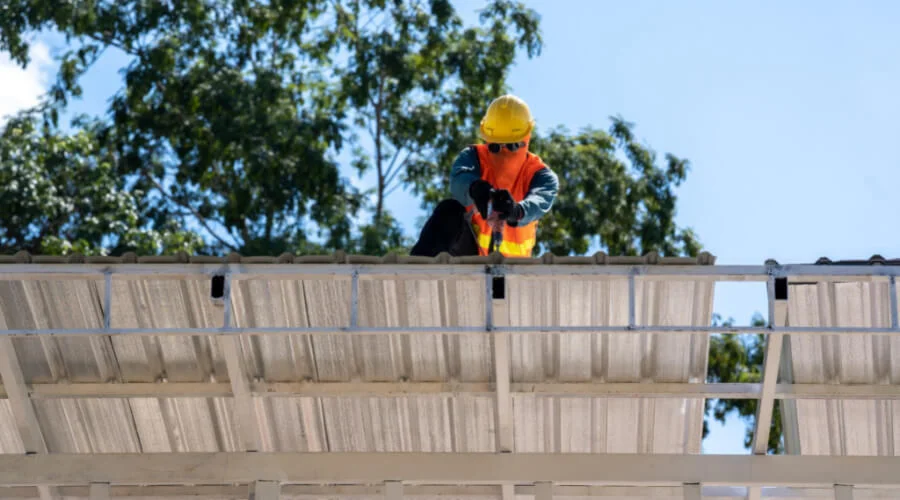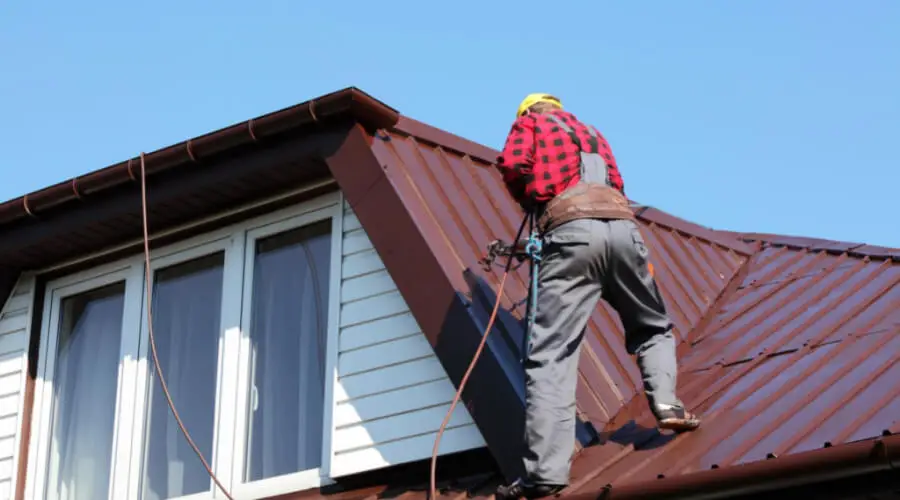Last Updated on July 16, 2023 By Emma W. Thomas
The weight of metal roofing can vary depending on the specific type and thickness of the metal used. On average, metal roofing typically weighs between 50 to 150 pounds per 100 square feet (approximately 4.65 to 13.9 kilograms per square meter). Lighter metal options, such as aluminum, generally weigh around 50 to 70 pounds per 100 square feet, while heavier metals like steel can range from 100 to 150 pounds per 100 square feet.
Comparison Among Metal Roofing And Other Roofing Materials
Even with metal being labeled a heavy roofing material, it is lighter than other available options.
Concrete weighs approximately 75% more than some other metallic roofing materials, while Asphalt shingles weigh about twice as much as steel roofs.
You can use metal as the skeleton of a roof and roof skeleton covers and have zero weight issues.
Here are some of the roofing materials and their weight per square foot:
- Wooden shingles weigh approximately 3 to 5 pounds per square foot.
- Asphalt shingles weigh between 2 to 4.5 pounds per square foot. Textured asphalt shingles are heavier, and they may be as heavy as 3 pounds up to 5 pounds per square foot.
- Clay or concrete roofing tiles are the heaviest roofing substances. Their weight can range from 5.5 pounds to 10 pounds per square foot.
The weights of the different roofing materials cannot even compare with the heaviest metal roof. Steel, which is the heaviest, weighs 0.7 to 1.5 pounds per square foot
Metal Roof Gauges And How They Affect The Weight
Manufacturers in America use a gauge to identify and differentiate the different thicknesses available for metal roof panels. The gauge starts at 22 and goes up to 29 gauge; 22 is the thickest, and 29 gauge is the thinnest.
Knowing the different sizes of panels available helps you make an informed decision as a homeowner. You can choose to go for 22, 24, 26, or 29-gauge metal panels based on your needs and budget.
22 gauge is the thickest and hence the heaviest of the available metal panels. It offers more protection and can withstand adverse weather comfortably. These size metal panels are commonly used in industrial areas. Being the thickest, these panels weigh about 1.25 to 1.48 pounds per square foot.
24-gauge, these panels are almost as thick as the 22-gauge. They are strong and would maintain their original look for a long time. Due to their thickness, they can be expensive to purchase. A 24-gauge panel weighs approximately 1 to 1.156 pounds per square foot.
26-gauge, residential houses, and commercial buildings choose this size of metal sheets. The metal panels with this thickness do not offer the same protection as the other two gauges, but they do a good job in areas that experience moderate weather conditions. The weight on this panel will start from 0.75 pounds to 0.91 pounds per square foot.
29 gauge is the thinnest of the available metal panels and also the cheapest. Residential houses also use these metal panels as roofs. However, if you live in regions that experience strong winds and blizzards, you require thicker panels, and therefore, 29 gauge might not be the best. These are the lightest of all and can weigh between 0.56 pounds and 0.625 pounds per square foot.
Calculating The Weight Of Your Metal Roofing
Calculating the weight of your metal roofing is an essential step in planning for construction or renovation projects. Knowing the weight of the roof is crucial for determining if the building structure can support it and for estimating transportation and installation costs. To calculate the weight of your metal roofing accurately, several vital factors need to be considered:
- Metal type: Different metals, such as steel, aluminum, or copper, have varying densities, which directly affect their weight. Knowing the specific metal type and its density is essential.
- Roofing profile: The profile of the metal roofing, like standing seam, corrugated, or ribbed, influences the weight. Each profile has a different thickness and shape, affecting the overall weight.
- Panel size: The dimensions of the metal roofing panels play a significant role in determining weight. Longer and wider panels will naturally be heavier than smaller ones.
- Gauge or thickness: The thickness or gauge of the metal roofing material affects its weight. Thicker metal sheets will generally be heavier.
Once you have gathered the necessary information, you can calculate the weight using the following formula:
Weight = Area × Density
The area can be calculated by measuring the length and width of each metal roofing panel and multiplying them. The density is specific to the metal being used and can be obtained from reliable sources. It is essential to note that the weight calculated using this formula represents the weight of the metal roofing material only and does not include any additional fixtures, insulation, or underlayment. Therefore, it is crucial to account for these additional factors separately to get an accurate estimate of the total roof weight.
What Are The Different Types Of Metal Roofing Materials?

Metallic roofs may be made of different substances. The primary ones are:
1. Aluminum
This material is lightweight and appropriate for regions with excessive moisture due to its corrosion-resistant properties. Aluminum has the highest weight-to-energy ratio of the various metallic roofing materials. It weighs an average of 0.7 pounds per square foot.
2. Copper
Roofs made from copper will survive for many years. The material develops a defensive layer and changes colors as time goes by. The price tag on this roof is high, but it is one of the most reliable metal roofs. Copper Roofing can be available in different forms like shingles, sheets, tiles, or even panels. On average, copper weighs 1.25 pounds per square foot.
3. Steel
Initially known as tin, steel is well known for its low upkeep, durability, and affordability. It has been utilized in residential homes contrary to before when it was exclusively used in commercial buildings. Again steel is the heaviest of all metals, weighing around 0. 7 to 1.5 pounds per square foot.
4. Zinc
In Europe, zinc Roofing is very common, unlike in the United States of America due to its high price tag. Zinc copies several copper attributes like changing color after some time because of exposure to different weather conditions. The material is loved because of its aesthetic nature. The zinc panels can be pre-painted, but the material will change color. Zinc weighs an average of 1.43 lb per square foot.
Weight Of Metal Roofing Materials
| Metal Roofing Material | Pounds per square foot |
| Aluminum | 0.7 lbs |
| Copper | 1.25 lbs |
| Steel | 0.7-1.5 lbs. |
| Zinc | 1.43 lbs. |
Benefits Of Using Metal Roofing Materials Over Other Available Materials

All roofing materials have their advantages over others. However, in this instance, we will pay attention to the benefits of metal over other roofing materials.
1. Lightweight
All the other roofing materials are substantially heavier than steel. The heavier the material, the harder it is for the contractor to install.
A light material reduces the load held up by the foundation and walls. Heavier substances require sturdier roof skeletons to hold the weight without giving in.
3. Malleable
Steel sheets, panels, and even tiles may be molded or cut into sizes that fit perfectly within the point of installation.
Companies that make metallic roofing can reduce and provide roofing sheets within a specific size to ease your roof installation. Other materials require careful planning, which can take time during production and installation.
4. Attractive
Metal roofs come in various colors and shapes. Some materials like copper and zinc change their color after some time giving your home a makeover without the problem of changing your roof.
The steel sheets or panels can be painted in different colors of your choice. So, if you need to customize your house, metal roofing is the way to go.
5. Easy To Install
Metallic roofing is light making installation easy; lifting a sheet, tile or panel is easy and can be executed with the help of one individual. Other materials which might be heavier require more energy to move from one point to the other. The heavier the material, the more time and money will be spent to finish the job.
6. Pocket Friendly
The price of construction materials significantly impacts the overall cost. Metal roofs offer a cheaper alternative to roofing.
Copper is the highest-priced metallic roofing material but is less expensive than clay slates. For a client trying to reduce expenses, you should purchase metal roofing sheets. The different materials offer considerable costs, and you may select one based on your budget.
7. Low Upkeep
Unlike other roofing materials, metal needs next to zero maintenance. The material is not prone to damage because of changes in climatic conditions. It can survive in different weather conditions and come out unscathed.
Cleaning leaves and debris on a metal roof is easy. The sheets, tiles, or panels lie close to each other, leaving zero room for leaves to latch on. Most times, you will not even have to clean the roof because the dirt and gunk will slide off.
8. Long Lifespan
Metal is prone to rust; however, this is not a problem to worry about for the material used in roofing. Substances like copper, aluminum, and zinc don’t rust.
The life expectancy of metal roofs ranges from 60 to 100+ years. Even without maintenance and repair on the roof, the material can outlive all other roofing materials.
9. Fire And Rot Resistance
Metal is not a flammable material. While established nicely, metallic roofing has a good fire rating. This is the best option for humans residing in regions prone to fires.
Materials like wood will begin rotting, especially in humid areas. Metal does not hold moisture or absorb it; any liquid that touches it rolls off the ground.
Final Thought
Metal is one of the most reliable roofing materials on the market. It has a certain versatility level, making it a go-to product for many consumers. Even though its weight has been questioned over the years, the material has proven otherwise. Compared to its competitors, it comes out lightweight.
References:
https://www.americanmetalroofswi.com/the-weight-of-metal-roofing-per-square-foot/
https://digitalroofingcompany.com/blog/weight-of-metal-roof/
Emma is a graduate of Domestic Science or Family and Consumer Sciences (Home Economics) from the University of Wisconsin. She has 7 years of experience Working with the strategic section of BestBuy and now writing full-time for Homeeon.
From Managing the Home, Interiors, Cleaning, and Exteriors to Gardening and everything about Making A Home Liveable – is her passion and this Homeeon is the result of this.
Emma loves decorating her home with the best stuff found online. She cares about quality over anything and writes reviews about them here in Homeeon. Get in touch with her over Pinterest.
Keep reading her blogs.

